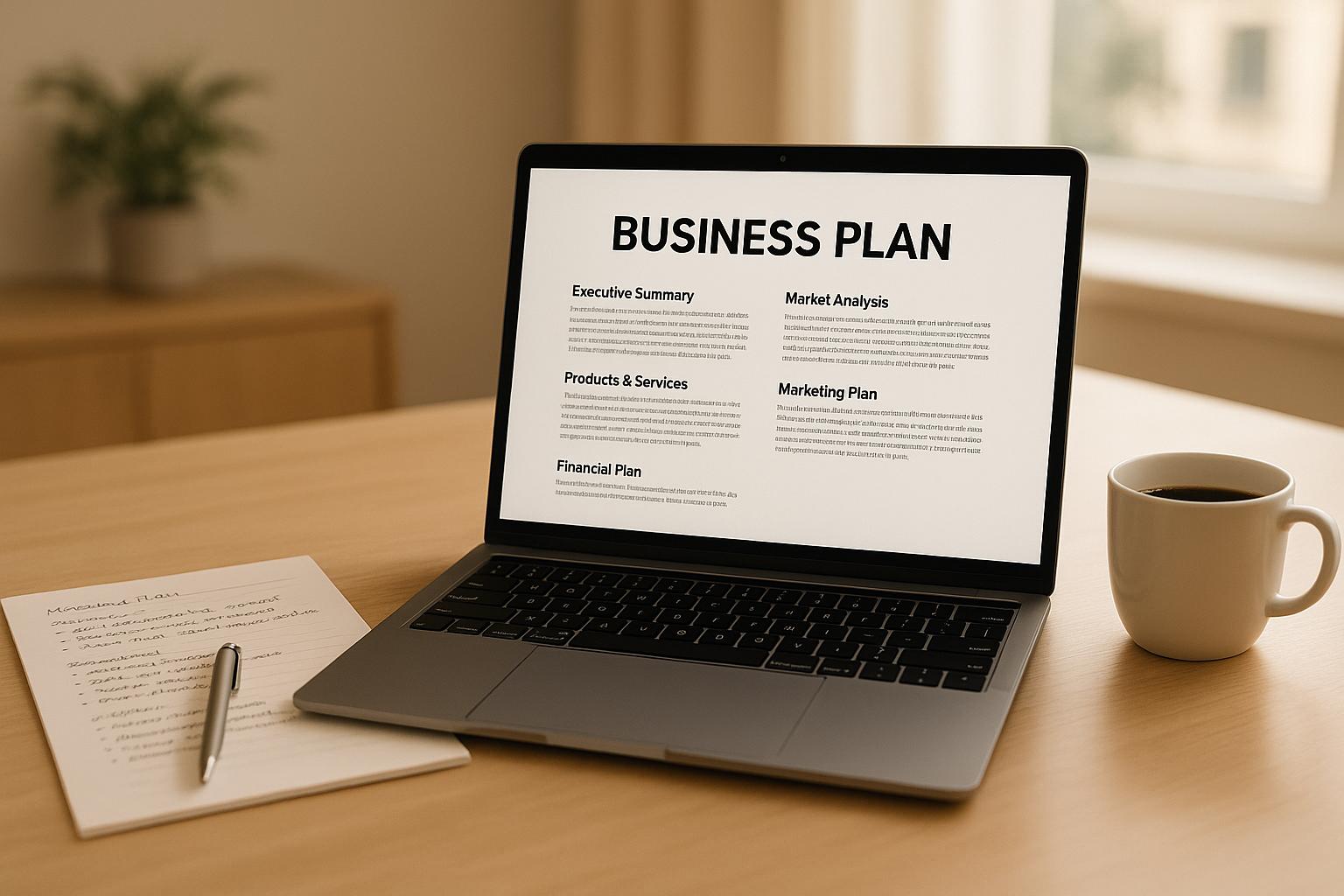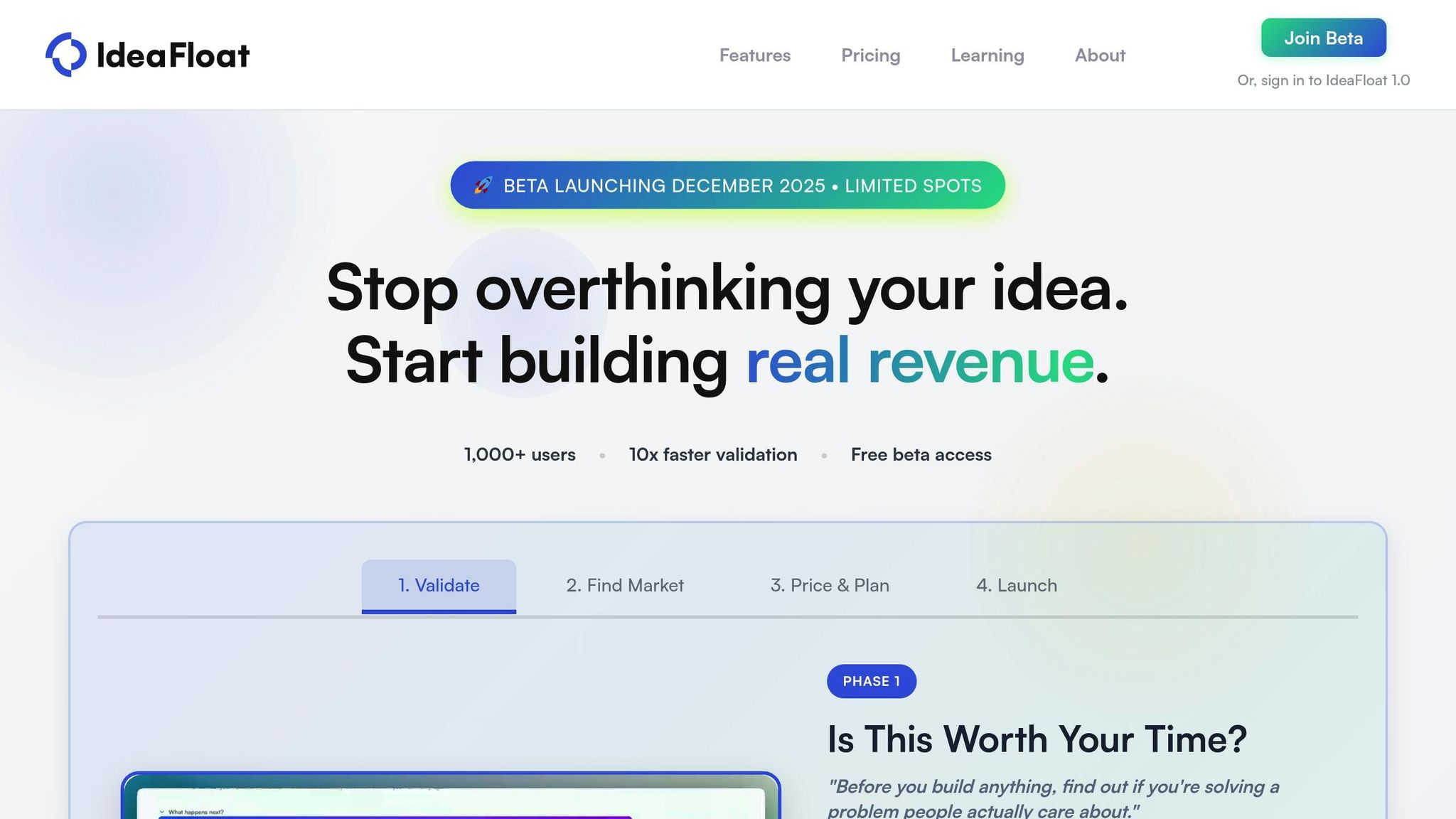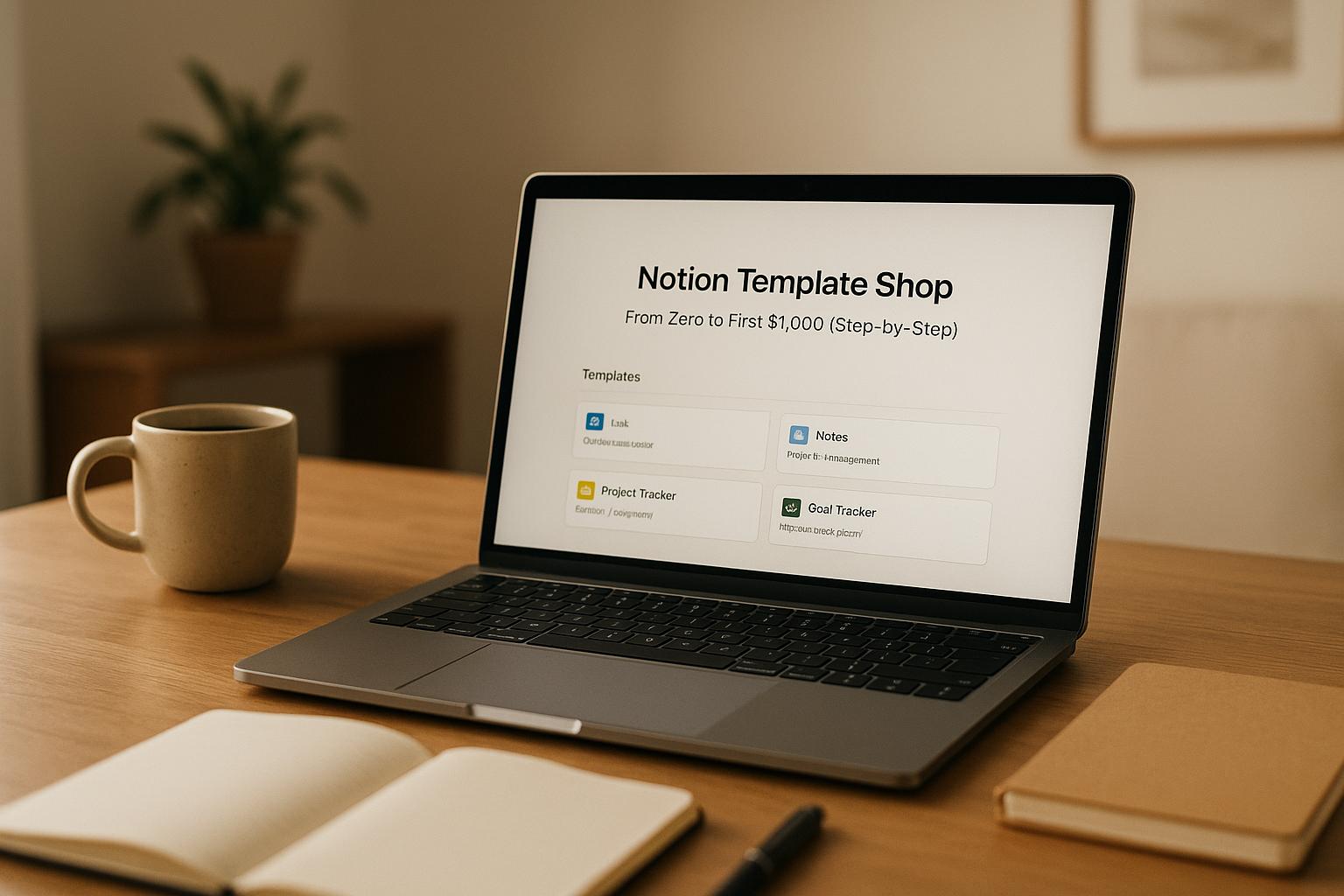
Want to turn scattered business ideas into a polished, investor-ready plan? AI tools like IdeaFloat can help you create a professional business plan quickly and efficiently. These platforms streamline the process by transforming raw notes into structured documents that meet U.S. banking and investor standards.
Key Takeaways:
- Why a Business Plan Matters: Banks and investors require detailed plans with financial projections, market analysis, and clear strategies.
- How AI Helps: Tools like IdeaFloat simplify financial modeling, market research, and formatting. Provide your input, and the AI generates a professional plan in hours instead of weeks.
- Preparation Tips: Organize your notes into categories like business concept, financial estimates, and market research for the best results.
- Final Output: Export a polished PDF that includes all key sections, formatted to meet U.S. standards.
AI reduces the complexity of business planning, giving you more time to focus on refining your strategy and securing funding.
The Best AI Business Plan Writer of 2025 (And The Ones to Avoid)
Getting Your Business Notes Ready for AI Processing
Before you dive into using AI for your business plan, take a moment to get your notes in order. Think of this as laying the groundwork - well-prepared notes lead to better results. While AI tools are incredibly powerful, they work best when given clear, organized input. This ensures that the business plans they generate meet professional standards, like those required by banks.
The quality of your AI-generated plan often depends on how well you've prepared your initial information. If your notes are scattered or incomplete, the AI might fill in the blanks with generic assumptions that don't truly represent your business. But when you provide detailed, structured notes, the AI can create a plan that highlights your unique vision and strengths.
Let’s walk through how to gather and organize your information so the AI can deliver the best results.
Collecting Your Key Business Information
Start by gathering all your business-related ideas and research in one place. This includes everything from rough sketches and brainstorming notes to detailed market research, financial estimates, and customer feedback. Think of it as creating a "master file" that covers every aspect of your business.
Focus first on your core business concept. Clearly describe your product or service, the problem it addresses, and who your target audience is. Be as specific as possible about your audience, as this will help the AI produce a more accurate market analysis and financial projections.
Next, collect your financial data. Include startup costs, expected revenue, pricing models, and the reasoning behind these figures. For instance, if you’re asking for a $50,000 loan, explain how you arrived at that number and how you plan to use it. Even rough estimates are fine - the AI can refine them using industry benchmarks.
Don’t forget to analyze your competition. List both direct and indirect competitors, along with their pricing, market position, and any weaknesses you’ve noticed. If you’ve researched market size, include that too. If your business will serve specific U.S. regions, note which states or areas you’ll target initially and how you plan to expand.
Operational details are just as important. Outline your business model, revenue streams, staffing needs, key partnerships, and any industry-specific regulations. For example, if you’re starting a food truck in California, mention the permits you’ll need, health department requirements, and how seasonal factors might impact your sales.
How to Structure Your Notes for Best Results
When it comes to AI, organization is key. Instead of dumping all your information into one document, group related ideas into categories. This helps the AI understand how different aspects of your business fit together, resulting in a more coherent plan.
Use clear headings like Business Concept, Target Market, and Financial Projections to structure your notes. Under each heading, use bullet points or short paragraphs to outline key details. This format mirrors the structure of professional business plans, making it easier for AI to generate polished sections.
For financial projections, be specific about your assumptions. Don’t just write, “Expect $100,000 in first-year revenue.” Instead, explain the logic behind it: “Targeting 50 customers per month with an average purchase of $167, based on local market research showing similar businesses serve 40-60 customers monthly.” This level of detail allows the AI to validate your assumptions and suggest adjustments if needed.
Include precise numbers and timelines. For example, instead of saying, “Plan to hire employees soon,” write, “Plan to hire 2 part-time employees by month 6 and a full-time manager by month 12, based on projected customer growth.” These specifics help the AI create realistic models and timelines.
Keep your tone conversational but informative. Think of explaining your business to a knowledgeable friend. Avoid unnecessary jargon unless it’s essential to your industry, and if you do use technical terms, briefly explain their relevance.
You might also want to create a separate document for supporting data - things like market research findings, competitor analysis, or customer survey results. Reference this data in your main notes but keep the detailed stats and charts separate. This keeps your core narrative clear while still giving the AI access to important supporting information.
Finally, review your notes to make sure they cover the essentials. Have you addressed what problem you’re solving, who your customers are, how you’ll make money, your competitive edge, and how much funding you need? Missing answers to these questions could lead to generic AI responses that won’t impress investors or lenders.
Using AI Tools to Build Your Business Plan
Turn your organized notes into a professional, investor-ready business plan with IdeaFloat's Business Plan Generator. This tool takes your input and crafts it into a structured document tailored for banks and investors.
What’s more, IdeaFloat ensures your plan meets U.S. business standards. It transforms your insights and data into neatly arranged sections, so you can focus on refining your strategy instead of wrestling with formatting.
Here’s a closer look at how the platform works.
Entering Your Notes Through Conversational AI
With IdeaFloat’s conversational interface, sharing your business information feels as natural as chatting with a colleague. You simply describe your business concept, target audience, revenue streams, and financial needs in plain language. The AI takes it from there, asking follow-up questions to clarify details or address any gaps.
This process eliminates the stress of starting from scratch with rigid templates. Instead of staring at blank sections, you’re guided through a conversation that brings out the core elements of your business strategy.
Auto-Generated Business Plan Sections
Once you’ve provided your input, the Business Plan Generator organizes everything into a polished, professional layout. Key sections include:
- Executive Summary
- Market Overview
- Product or Service Details
- Financial Projections
- Operations Plan
The tool tailors each section to fit your specific business model and industry, incorporating relevant data and analysis to back up your funding request. The result? A coherent, well-structured plan that flows logically and maintains the professional tone expected by banks and investors.
Ensuring Compliance with U.S. Standards
IdeaFloat goes the extra mile to ensure your business plan aligns with U.S. conventions by:
- Displaying monetary amounts in U.S. dollars with proper formatting (e.g., $125,000).
- Using the MM/DD/YYYY date format throughout the document.
- Presenting measurement units in the imperial system.
- Adopting language and terminology familiar to American business practices.
This attention to detail ensures your plan resonates with U.S. stakeholders, whether they’re investors, banks, or other key decision-makers.
sbb-itb-08dd11e
Creating Financial Forecasts and Market Analysis with AI
Traditionally, developing financial forecasts and market analysis has been a time-intensive process involving weeks of research and complex spreadsheets. But with IdeaFloat's AI-driven tools, this process becomes faster and more efficient. These tools deliver bank-ready financial models and market insights in a fraction of the time, meeting the rigorous standards expected by U.S. investors. By handling data collection, calculations, and formatting, the platform ensures your projections are both accurate and aligned with the expectations of U.S. banks and investors.
Building Accurate Financial Projections
IdeaFloat’s Financial Projections & Breakeven Analysis tool simplifies the process of creating detailed monthly forecasts. It provides insights into when your business is likely to become profitable by analyzing revenue and expenses. The tool generates projections for cash flow, profit/loss, and funding needs, all formatted in U.S. dollars with dates in the MM/DD/YYYY format.
Key features like breakeven analysis - showing the sales volume required to cover costs - and precise funding calculations ensure your financial plan is tailored to your business model and growth timeline. Additionally, these projections align with industry standards, presenting a professional and cohesive narrative to potential lenders. By integrating this level of detail, your financial figures become a seamless part of your broader business strategy.
Market Analysis for U.S. Markets
IdeaFloat’s AI doesn’t stop at financials - it also sharpens your market analysis. The Smart Market Sizing feature calculates Total Addressable Market (TAM), Serviceable Addressable Market (SAM), and Serviceable Obtainable Market (SOM), providing investors with data they can trust. Using real-time information, the tool quantifies your market opportunity. For instance, if you’re planning a local restaurant, the tool might calculate your TAM based on U.S. food service spending, narrow your SAM to your specific cuisine and location, and estimate your SOM by factoring in local competition and capacity.
In addition, the Consumer Insights and Competitor Analysis tools offer a comprehensive view of your competitive landscape. By pulling data from online forums, review platforms, and industry publications, the AI provides behavioral insights alongside demographic data. Your market analysis can include pricing benchmarks and key customer acquisition channels, all presented in professional charts and graphs that integrate seamlessly with your financial forecasts. This unified approach ensures your market insights and financial projections work together to create a cohesive, bank-ready business plan.
What sets IdeaFloat apart is its ability to maintain consistency across your entire business plan. For example, if you adjust your pricing strategy, the tool automatically updates related elements like revenue forecasts, cash flow timing, and funding requirements. This synchronization eliminates the inconsistencies and errors common in manually prepared plans, ensuring your proposal is polished and professional - ready to meet the expectations of banks and investors alike.
Exporting and Polishing Your Bank-Ready PDF
Once you’ve wrapped up your forecasts and analysis, the next step is turning all that hard work into a polished, bank-ready PDF. This final document should not only reflect your business insights but also meet the expectations of U.S. investors and banks. It’s all about making sure your content is well-organized, visually appealing, and professionally formatted.
Using IdeaFloat's Export and Formatting Tools

With IdeaFloat's Business Plan Generator, creating a professional business plan is straightforward. This tool compiles all the critical elements - your research, financial projections, and market analysis - into a well-structured document that U.S. banks are accustomed to seeing. Typically, these plans range from 15 to 25 pages, covering everything from your Problem Validator insights to your Financial Projections & Breakeven Analysis. It also integrates market sizing, go-to-market strategies, and pricing research seamlessly with the financial data.
If you need something more concise, IdeaFloat’s Lean Canvas tool is perfect. It creates a one-page summary by pulling data directly from your workspace. This format is ideal for quick investor pitches or discussions with mentors, offering a snapshot of your business concept while staying consistent with the full business plan.
Both tools ensure your exports are ready in multiple formats, giving you flexibility in how you present your plan. The automated formatting takes care of professional spacing, font consistency, and section breaks, so you don’t have to worry about design details.
Once you’ve exported your plan, the next step is a thorough review to ensure it meets professional standards.
Final Review for Professional Standards
Before sharing your plan, focus on three key elements: financial transparency, funding clarity, and clear, measurable objectives.
- Financial transparency is non-negotiable. Your plan must clearly show how your business will generate enough profit to provide a solid return on investment. Double-check that your financial projections, market analysis, and pricing strategy align perfectly.
- Funding clarity is just as important. If you’re seeking financing, spell out exactly how much you need and provide a detailed breakdown of how the funds will be used - whether it’s for working capital, equipment, or operating expenses.
- Measurable objectives ensure your plan functions as a clear roadmap. Define your company’s goals and explain how you’ll achieve them.
Also, take a close look at consistency. For instance, if you’ve listed a specific cost in your go-to-market strategy, make sure it matches your overall financial projections. Similarly, check that your market sizing assumptions align with your revenue forecasts. Investors will notice any inconsistencies, so it’s crucial to get these details right.
Once your data is verified, it’s time to focus on presentation.
Creating a Professional Presentation
The way your business plan looks can greatly influence how investors perceive it. IdeaFloat’s Branding Guide helps you maintain a consistent visual identity throughout the document. It provides professional color schemes, typography guidelines, and logo usage standards, making your plan look polished and cohesive. This attention to detail reinforces the credibility of the data-driven content you’ve created.
Visual elements also play a big role in breaking up dense sections of text. Use charts for financial projections, graphs to illustrate market size, and tables to summarize key metrics. These elements not only make your plan easier to read but also highlight the depth of your research.
Conclusion: From Ideas to Bank-Ready Plans with AI
Transforming scattered notes into a polished, professional business plan no longer needs to take weeks - or even days. Thanks to AI tools, entrepreneurs can now approach business planning with efficiency and confidence, turning what was once a tedious process into an achievable task.
One of the biggest perks of using AI for business planning is the speed it offers without compromising on quality. AI business plan generators provide a structured, professional framework that includes all the critical sections - executive summary, market analysis, marketing plan, and financial projections - meeting the expectations of U.S. investors and lenders alike.
Beyond just streamlining the process, AI elevates the quality of your data analysis. It’s not just about crunching numbers; AI tools draw on market reports, industry benchmarks, and proven business models to deliver insights that are rooted in real-world data. This means your financial projections go from being educated guesses to data-driven estimates that investors can trust and verify.
AI also sharpens how your ideas are communicated. It takes raw notes and transforms them into polished, persuasive language that highlights your business's value. For example, rough thoughts about your target audience evolve into a clear, professional market analysis. Quick calculations turn into detailed financial forecasts, complete with charts and proper formatting.
And let’s not forget presentation. A visually appealing, well-organized document can make a lasting impression on investors. AI tools help you create professional visuals and layouts that signal you’re serious about your venture. A strong presentation can be the difference between securing funding and being overlooked.
With platforms like IdeaFloat, you get everything you need - from validating your initial idea to exporting a final, polished PDF. By letting AI handle the technical details, you free up time to focus on refining your strategy and building a plan that opens doors to funding and partnerships.
Your business idea deserves to shine. With AI managing the heavy lifting of plan creation, you can focus on what matters most: perfecting your vision and strategy.
FAQs
How can I make sure the AI-generated business plan aligns with my unique business goals and vision?
To create a business plan that genuinely aligns with your goals, it's crucial to provide clear and detailed information about your vision, target audience, and specific objectives. The more specific you are, the better the AI can craft a plan that truly reflects your business.
Include key details like your mission, the products or services you offer, your target market, and any standout elements of your strategy. These details help the AI move beyond basic templates and deliver a plan that captures what makes your business unique. Simply put, the quality of the plan depends on the clarity and depth of the information you share.
What key business details should I have ready before using AI tools like IdeaFloat to create my business plan?
Before diving into AI tools like IdeaFloat to craft your business plan, it's crucial to organize the core details about your business. Start with a clear business description - define your purpose, identify your target audience, and outline what makes your business stand out. Knowing your short-term and long-term goals is equally important, as it helps the AI tailor the plan to your vision.
You'll also want to gather essential insights about your market and customers. Think about demographics, market size, and current trends that could impact your business. Don’t forget to pull together basic financial details, such as estimated startup costs, projected revenue, and any funding requirements. The more structured and detailed your input, the better the AI can deliver accurate and professional results.
How does IdeaFloat ensure business plans meet U.S. banking and investor standards, and what key elements are included in the final PDF?
IdeaFloat leverages cutting-edge AI tools to craft business plans that meet the specific requirements of U.S. banks and investors. The platform ensures your plan includes critical components like precise financial forecasts, in-depth market analysis, and professional formatting that aligns with U.S. standards.
The completed PDF features all the essentials: a concise executive summary, detailed financial projections (presented in USD), insightful market research, and a well-defined business model. By automating much of the process, IdeaFloat helps you save time while delivering a polished, investor-ready document.
Related Blog Posts
Get the newest tips and tricks of starting your business!


